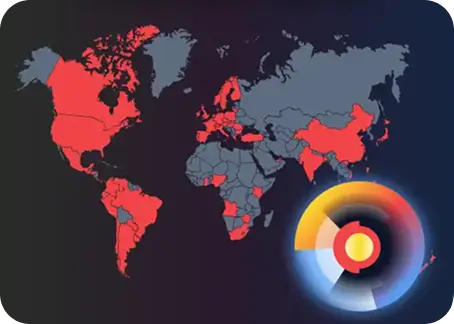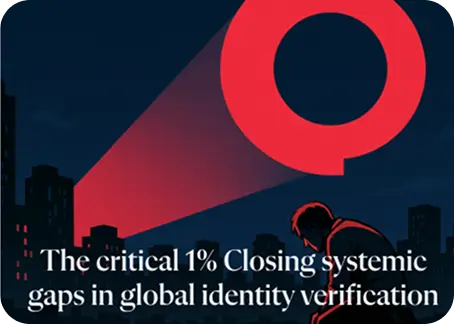Understanding the Challenges of Burmese Identity Documents
Effective identity verification in Myanmar (Burma) requires a thorough understanding of the unique
characteristics of Myanmar (Burma) identity documents. Shufti’s OCR and identity verification
systems are designed to address these challenges, ensuring high accuracy and compliance.
In this section, we will discuss the various challenges associated with verifying Myanmar (Burma) identity
documents, highlighting how our technology overcomes these hurdles to ensure seamless verification.
1. Diverse National Registration Cards (NRC)
Myanmar’s National Registration Cards (NRCs) have been issued in various forms over the decades. Older versions are often handwritten or typed, leading to poor document quality that can hinder OCR accuracy. Newer versions, while printed and laminated, still suffer from inconsistent design and font usage. There is no strict national standard for the layout of NRCs and other identification documents in Myanmar, leading to regional variations in font size, placement of key data points (e.g., name, birth date), and use of official stamps or seals. Furthermore, many citizens, particularly in conflict regions, possess different regional or community IDs, complicating standardized verification. Additionally, local governments may issue documents with unique designs or formats for specific purposes, such as travel or residency permits.
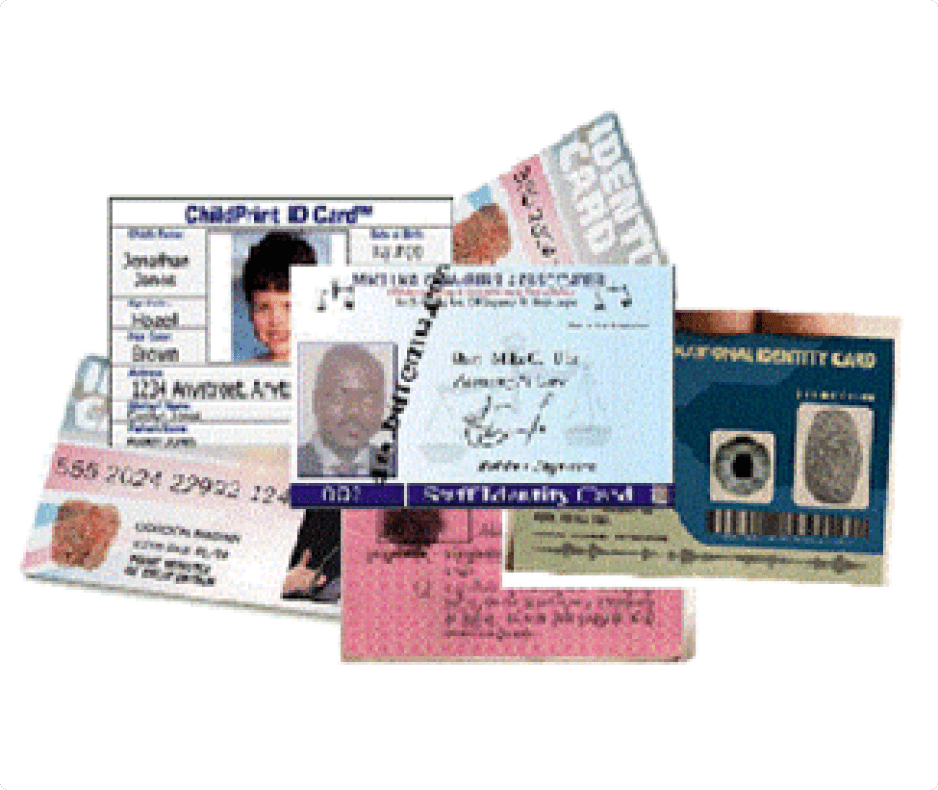
2. Bilingual and Multilingual Documents
Myanmar's official language is Burmese, but many documents, especially in border regions, are bilingual or even multilingual due to the country’s ethnic diversity.
For example:
Shan: Shan State uses a script derived from Burmese with unique tonal markers and vowels. "Water" is written as ၶၢဝ်ႈ ("khawn").
Karen: Southeastern Myanmar, like Sgaw Karen, use an adapted Burmese script. In Sgaw Karen, "water" is လီၤ ("lee"), while in Pwo Karen it's လၤ.
Kachin: The Kachin people in northern Myanmar speak several languages, but Jingpho (Jinghpaw) is the most prominent. The Jinghpaw (Kachin) language, spoken by the Kachin people in northern Myanmar, uses the Latin alphabet for writing. Unlike Shan and Karen, it does not use a script derived from Burmese. The word for "water" in Jinghpaw is written as shanglaw.
3. Language Nuances and Diacritic Challenges
The Burmese script contains several diacritic marks and special characters that modify the meaning of words or change the pronunciation of syllables. These marks are crucial for extracting accurate information, especially for names and addresses.
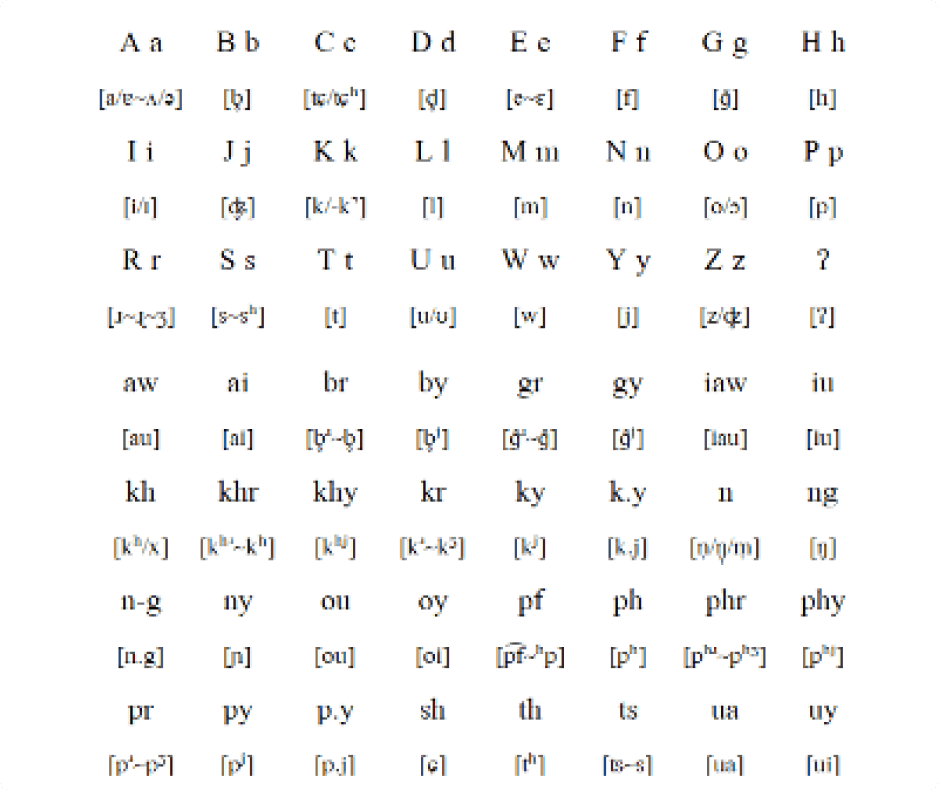
4. Burmese Native Calendar
Myanmar (Burma) documents may use varying date formats, including the traditional Burmese calendar in some rural areas, which differs from the Gregorian calendar. The Burmese calendar operates on a lunisolar system, combining both solar years and lunar months. It also has a different starting point for its era, known as the Burmese Era (BE), which began in 638 CE, while the Gregorian calendar starts at 1 CE. This means the Burmese calendar is currently approximately 638 years ahead of the Gregorian calendar.
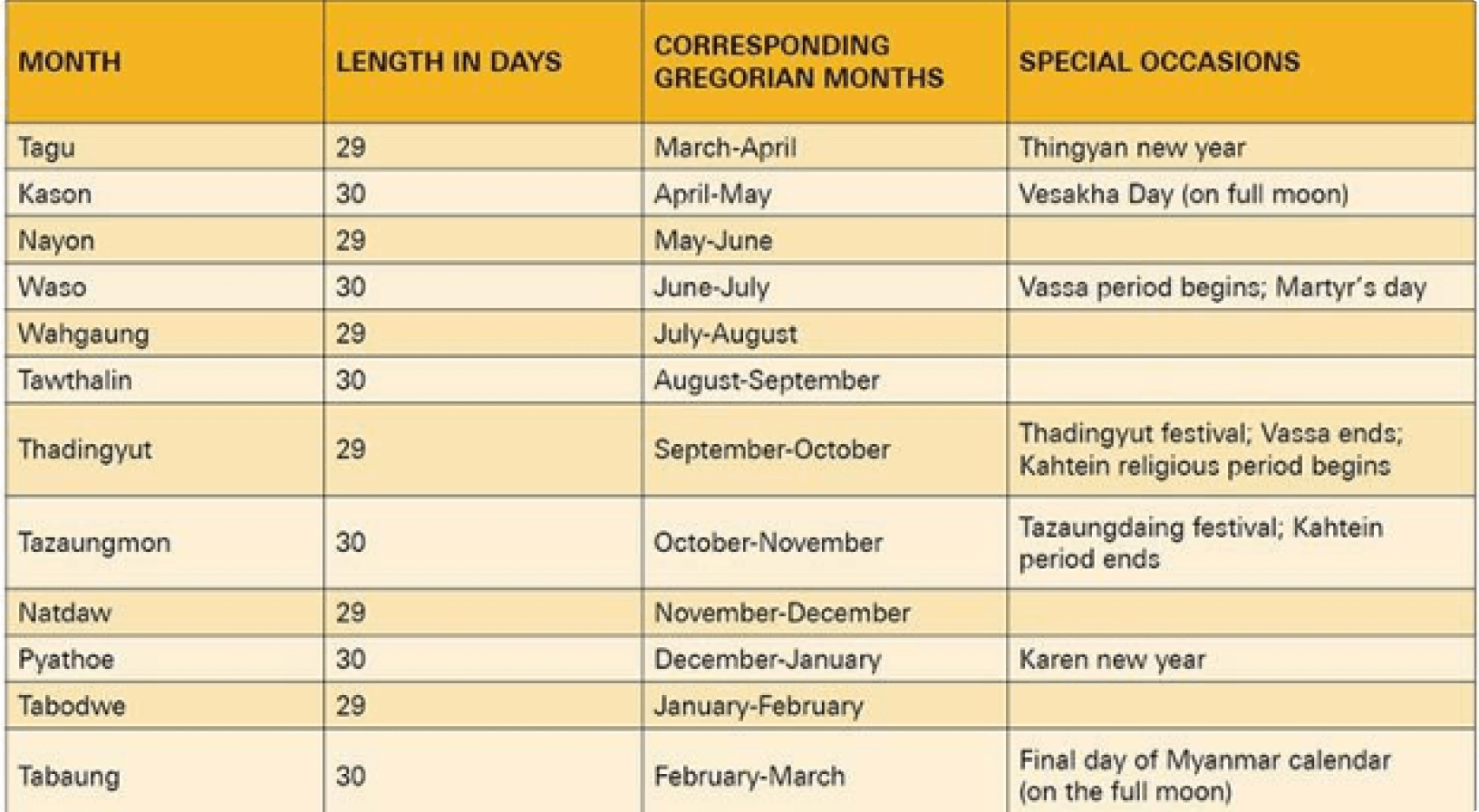
One significant difference is that the Burmese year often starts in April, aligned with the traditional Thingyan (New Year) festival, rather than in January as in the Gregorian system. Additionally, months in the Burmese calendar are based on lunar phases, meaning they don't align precisely with Gregorian months. As a result, date extraction and conversion between the two systems can be challenging, especially in documents that continue to use the Burmese calendar for religious or traditional purposes, such as astrological charts, monastic documents, or traditional property deeds.
5. Handwritten and Printed Variations
Many older NRCs and other identity documents are partially or fully handwritten, particularly in rural areas. These handwritten elements can include critical information like names, birthdates, and addresses, making automated verification difficult.

6. Document Aging and Wear
Older Burmese documents are often physically damaged or worn out due to prolonged use and poor storage conditions, especially in rural areas. Many citizens do not regularly update their identification, leading to faded ink, torn edges, or laminate peeling off.
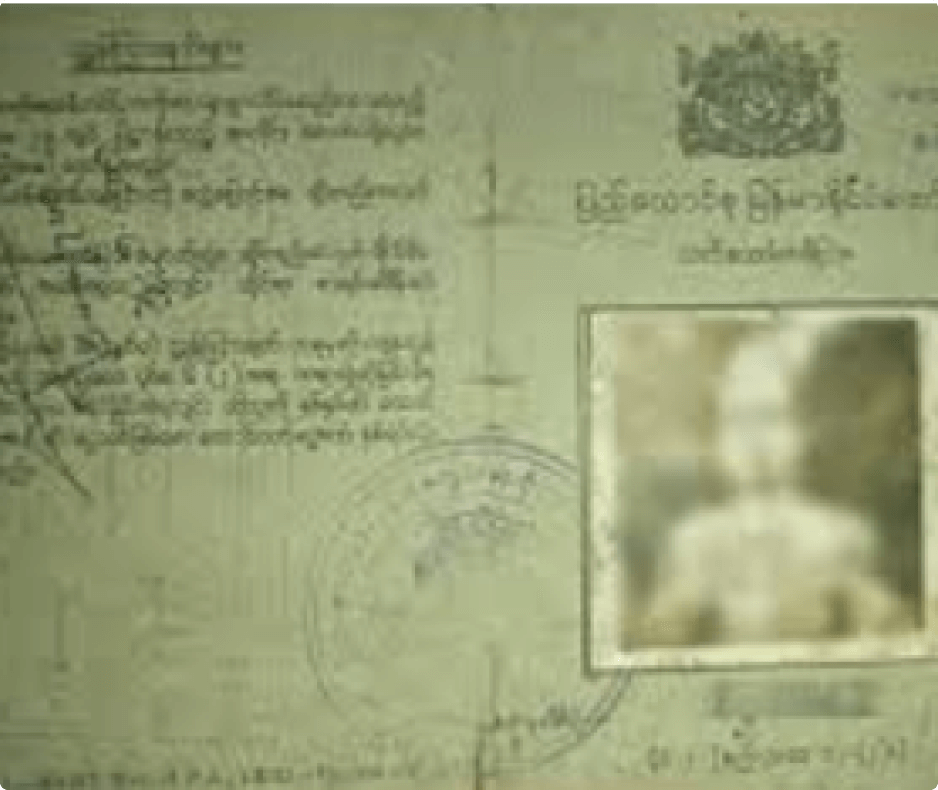
7. Challenges with Stateless or Refugee Documents
Refugees or stateless individuals within Myanmar often do not possess recognized national documents. Instead, they may have documents from international or humanitarian organizations that are difficult to verify through standard channels.
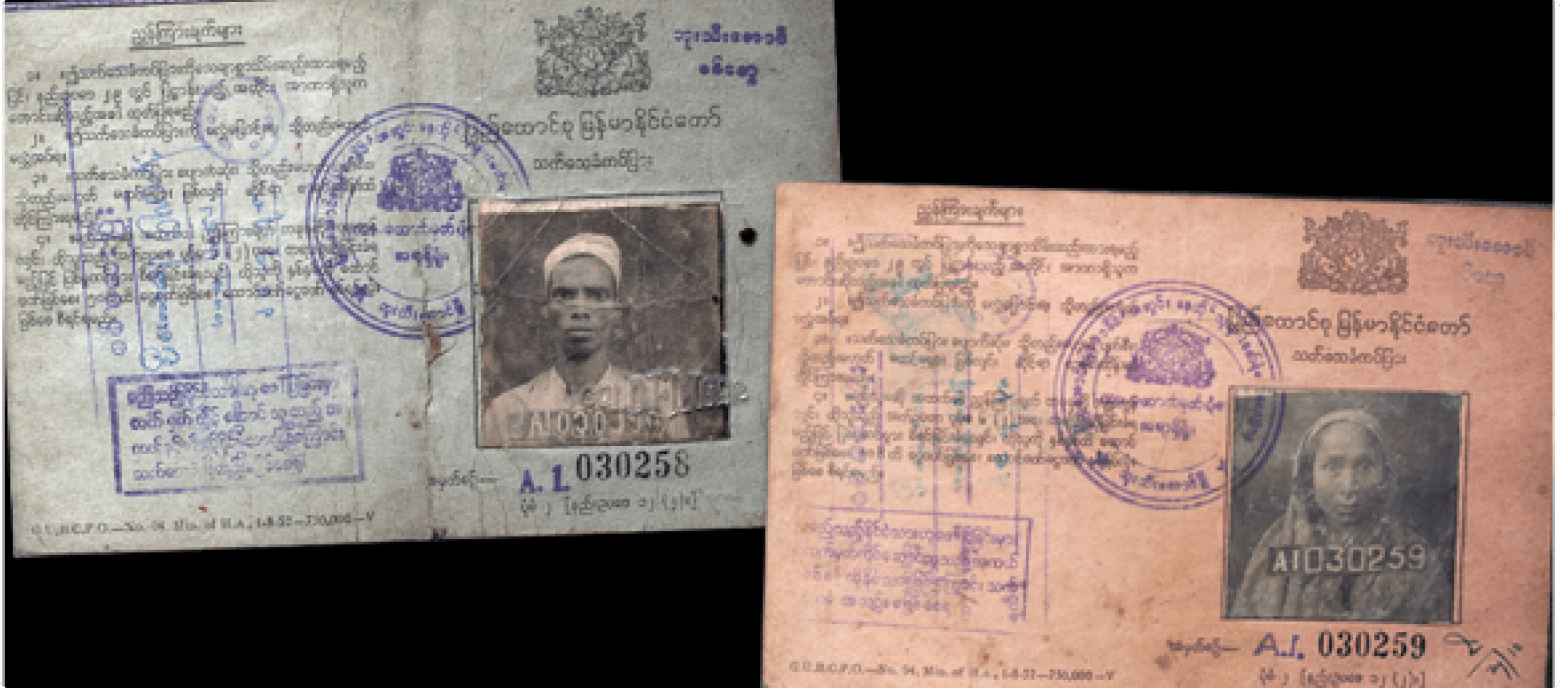
8. Outdated National Identity System
Myanmar’s National Registration Cards (NRCs) date back to the 1950s, with over 27% of the population, especially in rural areas, remaining unregistered. The slow shift to digital IDs complicates verification.
9. Stateless and Ethnic Groups
Myanmar is home to over 135 ethnic groups, and many, like the Rohingya, face challenges in obtaining formal ID. Shufti’s solutions incorporate alternative verification methods, such as biometric data, to verify these stateless populations. This flexibility allows businesses to onboard users from these communities while maintaining legal compliance.
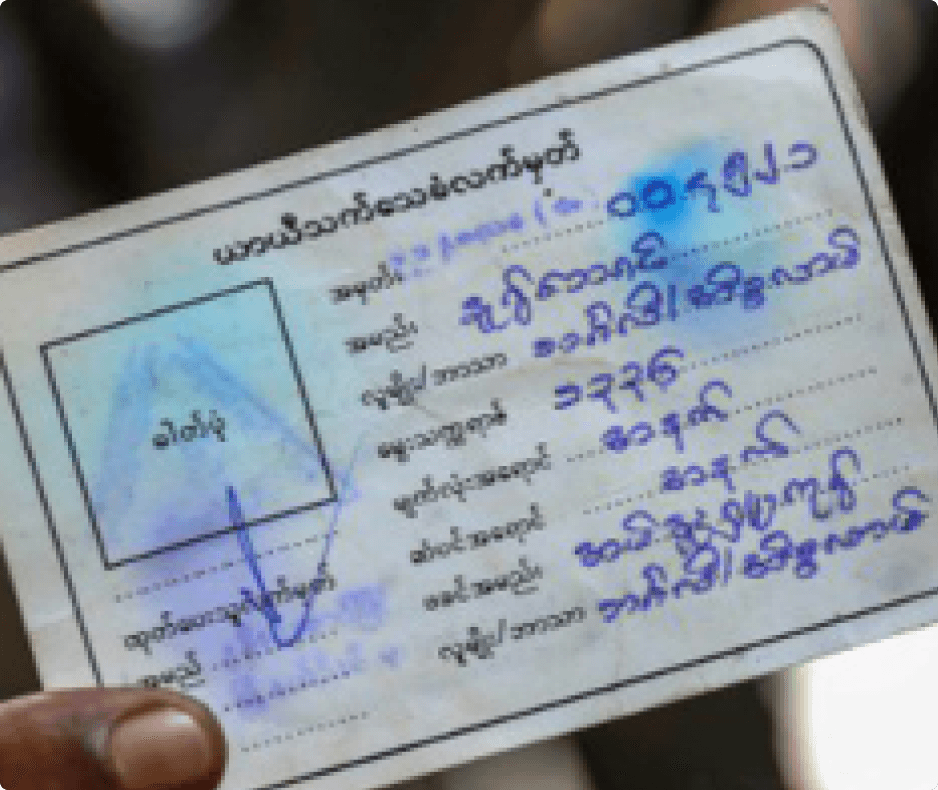
A Merchant’s Guide to Identity Verification in Myanmar
In Myanmar, merchants face unique challenges when verifying identity documents such as National Registration Cards (NRCs), passports, and various regional identification forms. To facilitate seamless integration and simplify the verification process, Shufti offers two verification modes: Onsite Verification and Offsite Verification. Each of these modes comes with considerations depending on the document type, verification method, and specific challenges encountered in the Burmese market.
Download the Top 10 Most Difficult Countries for Identity Verification
Download full report1. Verification Modes
Onsite Verification
Shufti’s Onsite Verification Mode offers merchants a user-friendly, real-time solution to identity verification using an iFrame/Verify component. This solution allows end users to submit necessary identity proofs such as NRCs or residence permits. The process is smooth and guided, with real-time feedback for the user to ensure document submission is correct. Once the process is complete, merchants can access verification results directly through the Shufti Back Office or API responses, enabling quick and efficient access to vital information.
Offsite Verification
Offsite Verification involves the client gathering identity documentation from users and submitting it for verification by Shufti. This method is more flexible and allows businesses to collect documents and data at their own pace. After submission, the results are returned either via the Back Office portal or through API responses. This method is particularly useful for merchants with large volumes of documents collected asynchronously or in regions where direct user engagement is challenging.
2. Document Types Selection
In Myanmar, various identity documents serve different purposes and offer varying levels of security and verification capabilities. Here's a brief overview of some of the key identification documents and their features:
National Registration Card (NRC): The NRC is the primary ID document for Myanmar citizens, and it is mandatory for individuals above the age of 10. These documents have different formats and design patterns for male and female nationals. It is a laminated paper with personal details (name, birth date, ethnicity, religion) and an NRC number. Older versions may feature English, but most are in Burmese. Ethnic minorities, especially the Rohingya, have historically faced difficulties in obtaining the NRC, limiting access to citizenship and essential services.
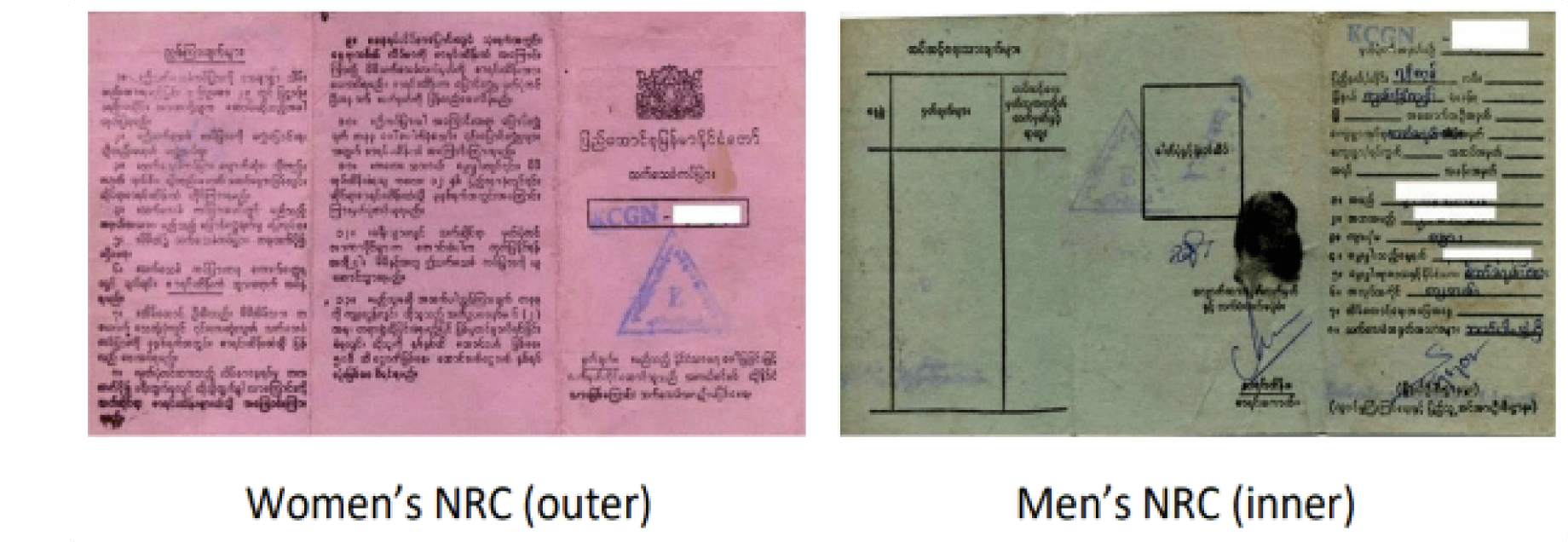
Citizenship Scrutiny Card (CSC): The CSC helps verify the citizenship status of individuals, making it a crucial document for determining different levels of legal rights. It is used for voting, accessing social services, and legal rights. It has different variants that denote access to legal rights.
Pink Card: Full citizenship for the Bamar majority and recognized ethnic groups.
Blue Card: Associate citizenship for descendants of immigrants after the 1948 Union Citizenship Law.
Green Card: Naturalized citizenship for long-term residents without full ethnic citizenship (e.g., Indians, Chinese).

Temporary Registration Card (TRC): Often referred to as "white cards," these were issued to individuals ineligible for full citizenship, such as the Rohingya. They provided limited legal recognition but were not a form of citizenship. These documents were discontinued in 2015, which worsened the statelessness of many Rohingya.
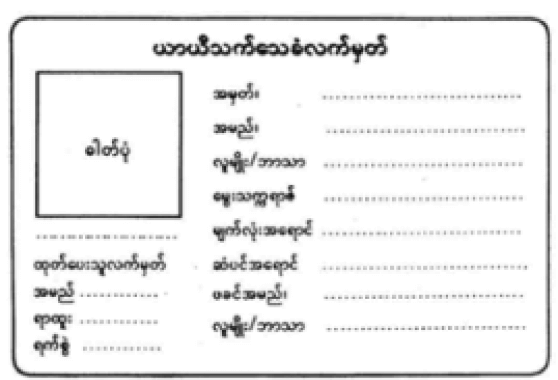
Household Registration Certificate (HRC): HRC registers households within a township, listing family members. It’s vital for voting, registering children, and accessing local services. The HRC is often requested for legal matters and serves as a supplementary document in disputes or other ID verifications.
Passport: Burmese (Myanmar) Passport contains different variants:
Ordinary Passport: For international travel, including personal and issuance details.
Diplomatic Passport: For diplomats and government officials.
Service Passport: For government workers on official business.
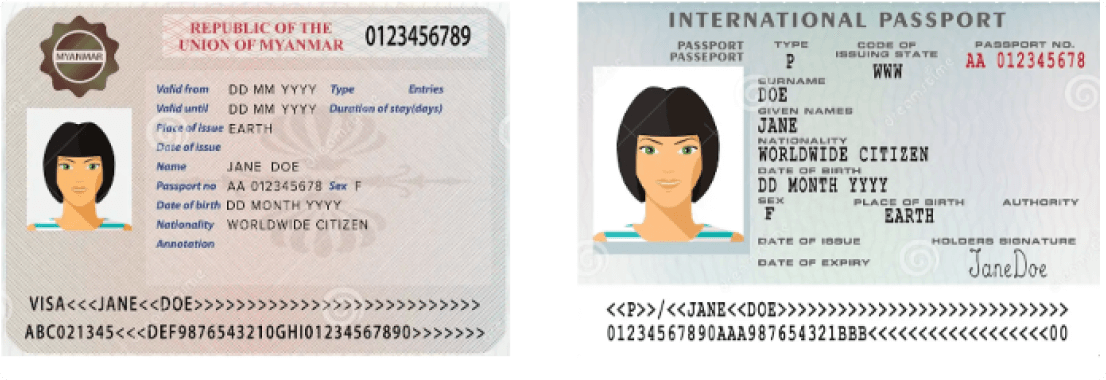
National Verification Cards (NVC): Introduced in 2015 for stateless individuals (e.g., the Rohingya) to begin verifying their citizenship status. These cards are turquoise. NVC is often viewed as inadequate and a temporary solution to the ethnic marginalization issues. While not providing full citizenship, NVCs may offer partial verification of status.
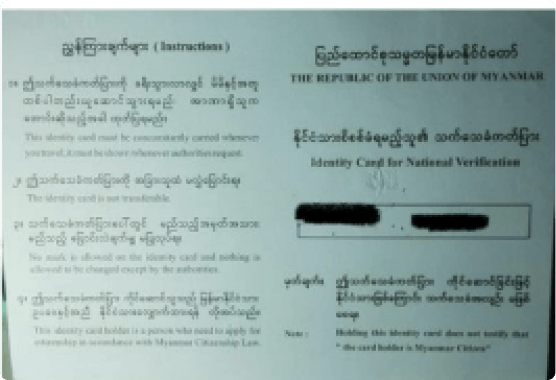
3. Document Type Preference and Performance
Different types of Burmese identity documents yield varying success rates in verification
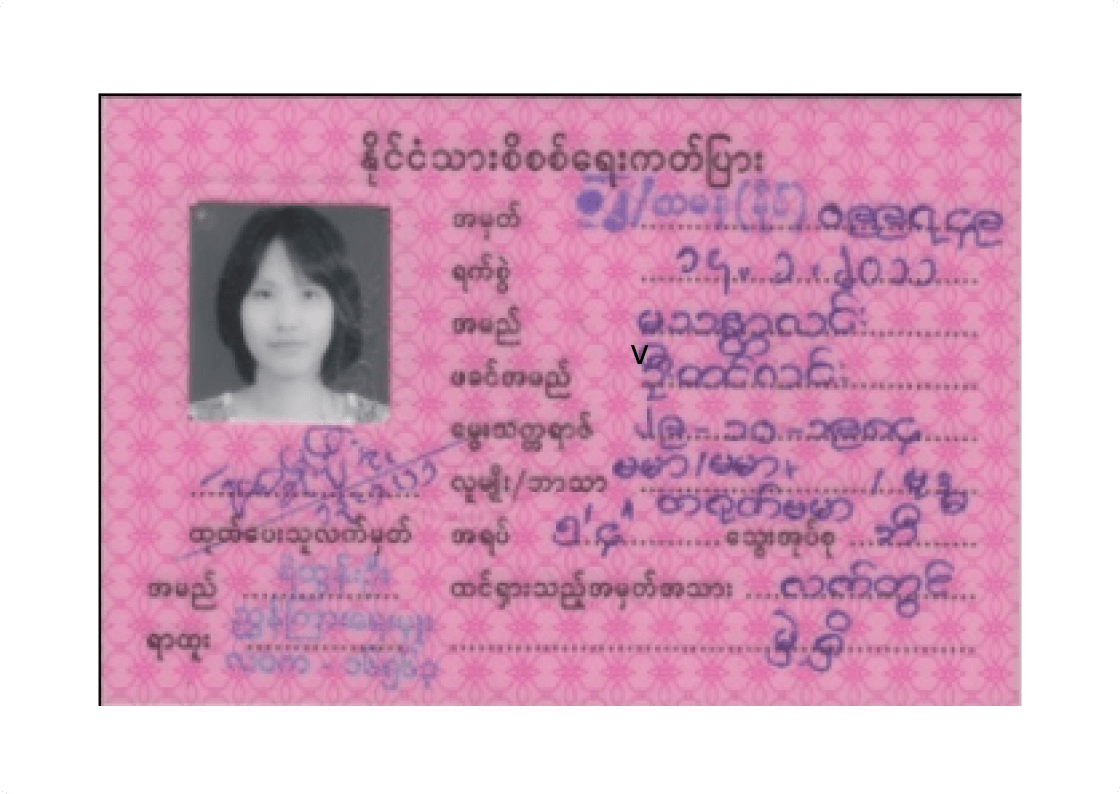
Citizenship Scrutiny Card
The Citizenship Scrutiny Card is the primary identification document for citizens of Myanmar, with different versions (pink, blue, and green cards) based on citizenship status. Shufti’s OCR technology is optimized to handle the unique layout and bilingual (Burmese and English) text. Regional variations and specific formatting of these cards are managed effectively by the system.
Format: Laminated
Extraction Parameters: Name, date of birth, issue date, document number
Driver's License
Burmese driver's licenses have varied designs depending on region and authority. Shufti’s OCR technology is optimized to handle these differences and accurately process handwritten or non-standardized data.
Format: Physical document
Extraction Parameters: Name, date of birth, issue date, document number, expiry date
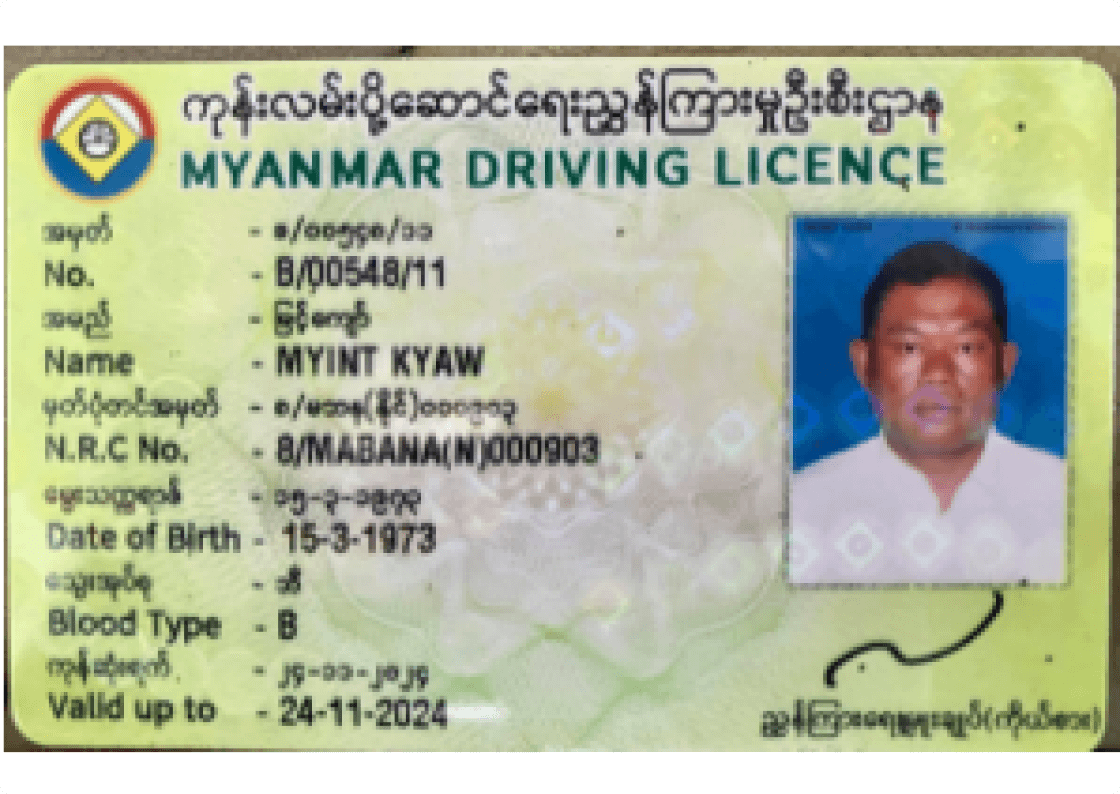
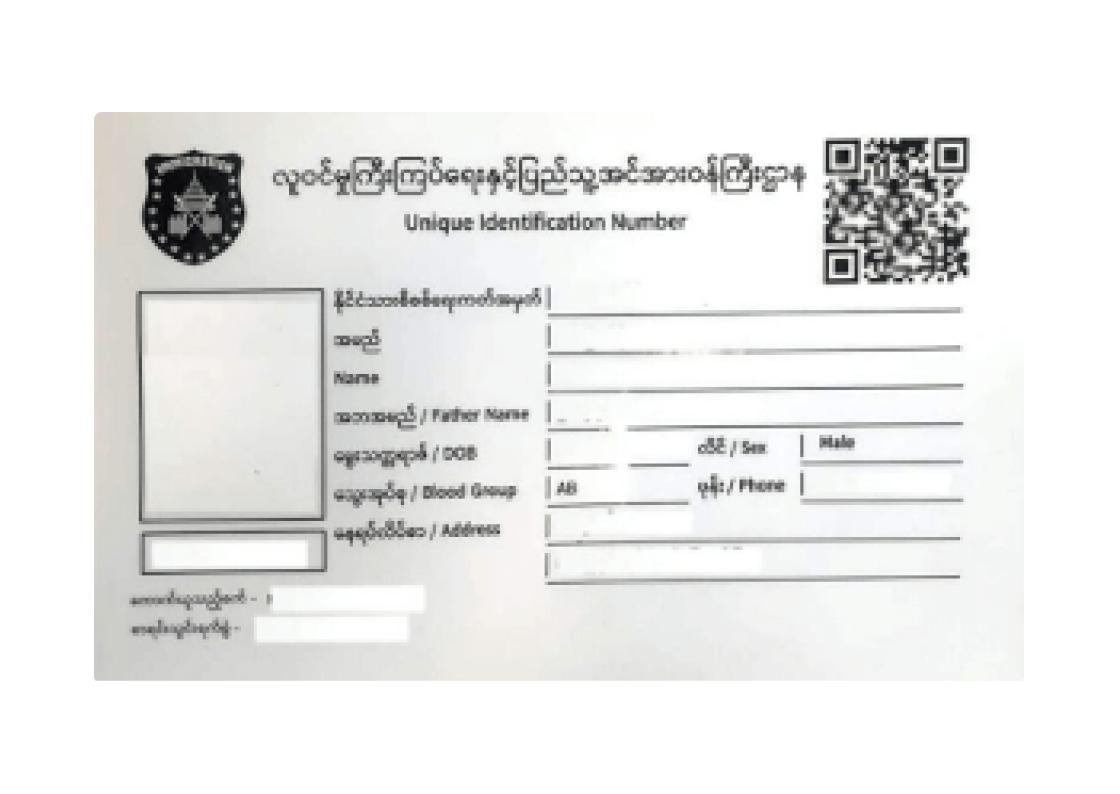
National ID Card
The new Myanmar National ID Card (Smart Card) is increasingly used for identity verification in administrative and financial tasks. Shufti’s systems are tailored to the card’s features, offering fast and accurate verification.
Format: Physical document
Extraction Parameters: Name, date of birth, issue date, document number, expiry date
Household Registration Card
This document is commonly used in Myanmar for non-financial identity verification tasks. Shufti’s OCR systems are trained to handle both typed and handwritten elements, capturing data accurately despite regional variations.
Format: Paper-based document
Extraction Parameters: Name, date of birth, issue date, document number
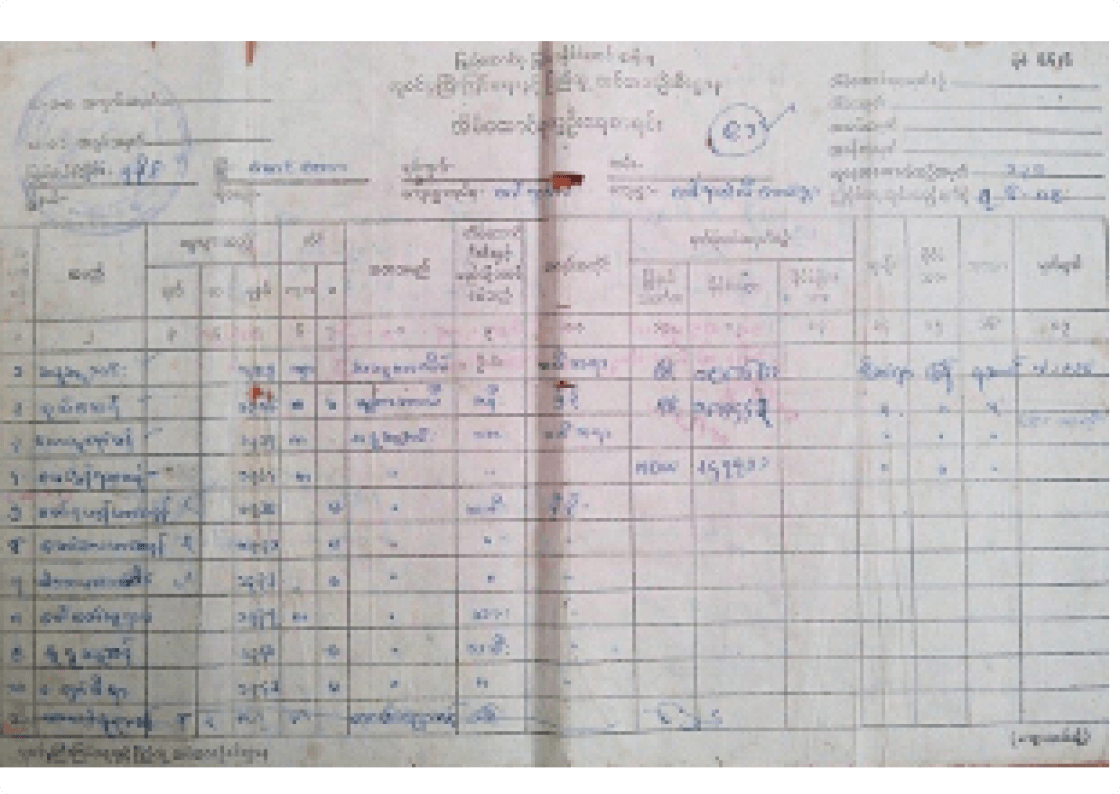
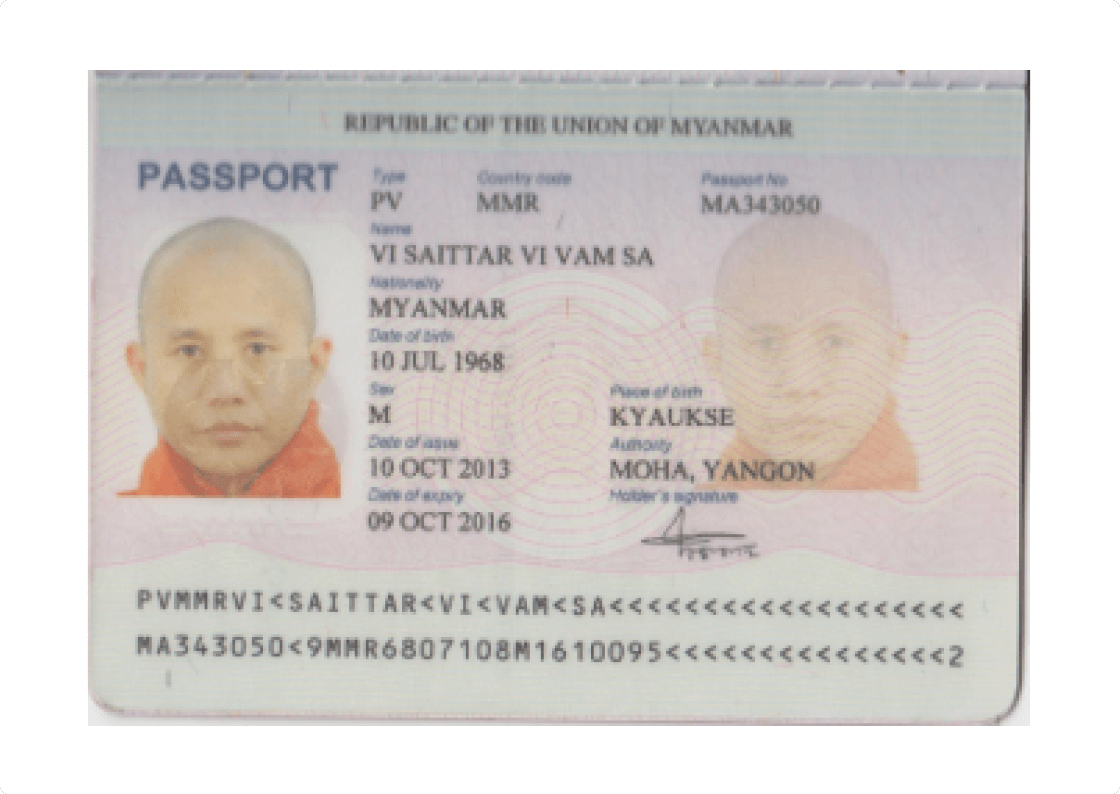
Passsport
Myanmar passport's complex security features pose challenges for OCR technology. Shufti’s advanced systems are fine-tuned to capture and verify all key details with accuracy, ensuring smooth and reliable processing.
Format: Physical document
Extraction Parameters: Name, date of birth, issue date, document number, expiry date
4. Preferred Document for Identity Verification
The Myanmar driver's license and Citizenship Scrutiny Card are highly preferred for KYC document verification in Myanmar due to their comprehensive coverage of essential verification parameters. These documents provide all the necessary details required for reliable and efficient identity verification, ensuring thorough compliance with KYC processes.
Verification Settings
1. Verification Mode (Onsite vs. Offsite)
Onsite verification is preferred in Myanmar (Burma) due to its higher accuracy and greater control over the verification process. This is particularly important in a market where document forgery is highly sophisticated. Onsite verification is ideal for sectors such as financial services and insurance that require immediate, high-accuracy results.
2. Data Extraction
Optical Character Recognition (OCR) is essential in Burma to accurately extract data from identity documents, especially those with complex characters like Shan, Karen, and Kachin. Advanced OCR systems are necessary to handle the nuances of Burmese scripts. Moreover, OCR should be efficient enough to convert Burmese dates to Gregorian calendar dates which are originally in the Burmese calendar.
3. Identity Document’s Backside Proof
Many Burmese identity documents contain crucial information on both the front and backside. For instance, the backside of the NRC often contains critical data, such as document numbers, addresses, and official seals. It is recommended to submit both sides of the NRC or other identity documents for comprehensive verification. Shufti’s system ensures that all relevant data is accurately captured and validated during the verification process.
4. Real-Time Proof Capture Vs. Proof Upload
Myanmar identity documents can be verified through two flexible proof methods: real-time proof capture and proof upload, giving users the option to choose their preferred method based on convenience and accessibility.
Real-Time Proof Capture
With Shufti’s advanced auto-capture technology, capturing identity proofs in real-time ensures a smooth, efficient, and accurate verification process. This feature automatically detects the document and captures it without requiring user intervention, making it one of the fastest and most reliable options for verifying physical documents.
Proof Upload
Users also have the option to upload pre-captured images of the identity documents. The upload process is seamless, allowing documents to be verified hassle-free. This is ideal for users who already have pre-captured images of their identity documents and prefer a straightforward upload and verification process.
Merchants can enable Allow Online (real time proof capture) and Allow Offline (proof upload) options available in the Verification setting tab. By offering both real-time capture and proof upload, Shufti ensures flexibility, providing the best user experience regardless of whether physical or electronic documents are being verified.
5. Device for Identity Verification
As of 2023, more than 90% of internet users in Myanmar access the web through mobile devices, with Android dominating the market. This trend emphasizes the importance of providing a mobile-optimized verification process. Shufti’s identity verification solutions are designed with mobile-responsive user interfaces that cater to the specific needs of smartphone users, ensuring that businesses can reach a wider audience while minimizing friction in the verification journey.
Download the Top 10 Most Difficult Countries for Identity Verification
Download full reportClick on a country to see the unique requirements that must be addressed.
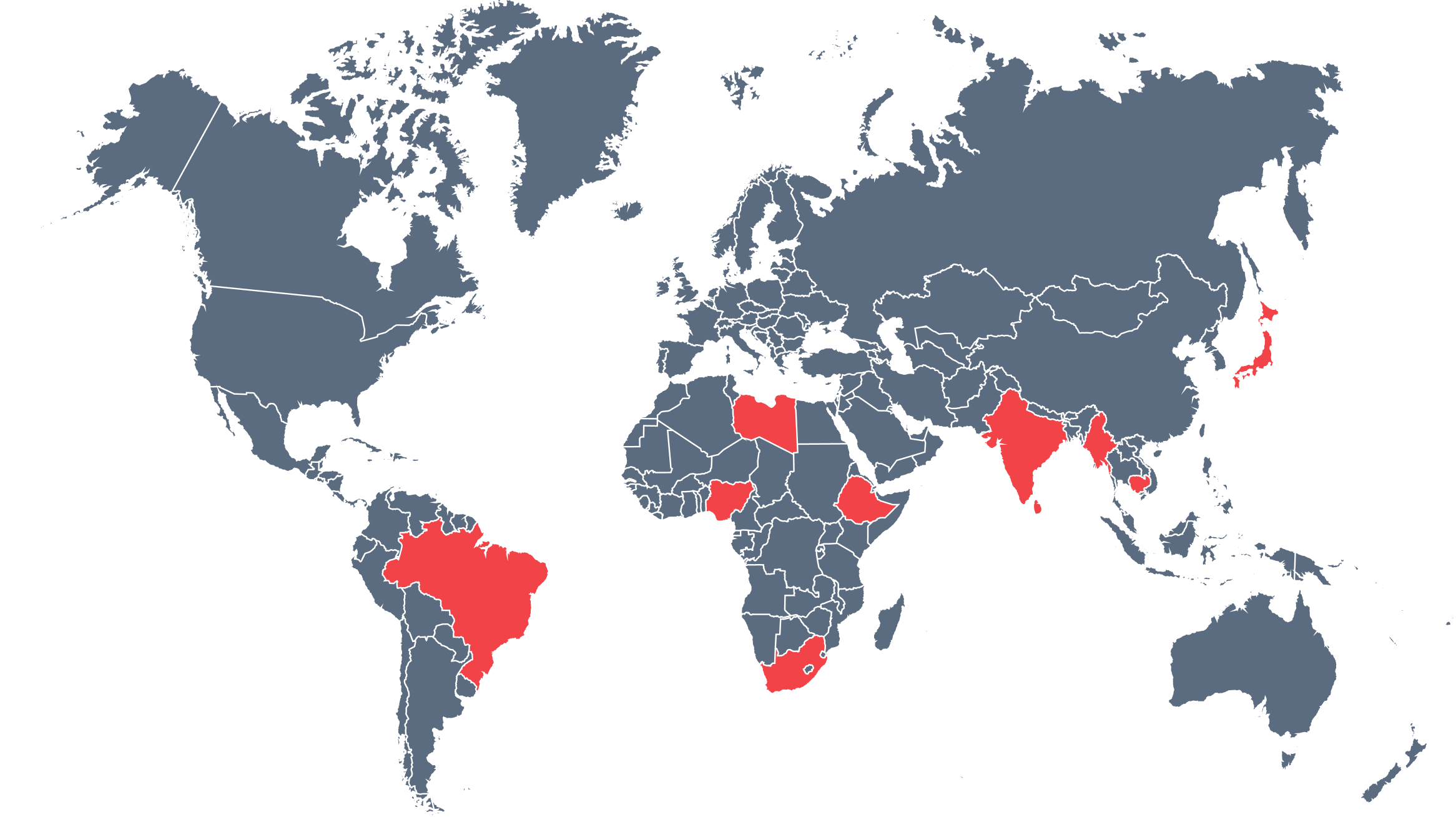

Brazil
Mastering Brazilian Identity Verification: A Merchant's Guide with Shufti
Effective identity verification in Brazil requires a deep understanding of the distinct features and challenges of Brazilian identity documents. Merchants must navigate different formats, languages, and security features to ensure reliable verification. This guide provides a comprehensive overview of Brazil's identity documents and the best practices for merchants engaging in identity verification.
Read Brazil’s Merchant Guide
Libya
Mastering Libyan Identity Verification: A Merchant's Guide with Shufti
Verifying identity documents in Libya presents unique challenges due to the country’s complex linguistic, social, and administrative structures. Implementing effective identity verification systems requires advanced technology to handle these specific hurdles. This guide explores the key challenges associated with verifying Libyan identity documents and how Shufti can help merchants overcome them.
Read Libyan’s Merchant Guide
Nigeria
Mastering Nigerian Identity Verification: A Merchant's Guide with Shufti
Nigeria’s identity verification systems are fraught with numerous complexities, arising from a combination of socio-cultural, infrastructural, and technological factors. As the country transitions towards digital identity solutions, recognizing and addressing these challenges is crucial for ensuring secure, accurate, and inclusive verification processes. Shufti’s OCR and verification technology is specifically designed to address these challenges and provide accurate, efficient, and reliable identity verification solutions.
Read Nigeria’s Merchant GuideMastering Indian Identity Verification: A Merchant's Guide with Shufti
Effective identity verification in India requires a comprehensive approach due to the distinct characteristics and complexities of Indian identity documents. Shufti’s OCR and verification technology is specifically designed to address these challenges and provide accurate, efficient, and reliable identity verification solutions.
Read Indian’s Merchant Guide
India

Ethiopia
Mastering Ethiopian Identity Verification: A Merchant's Guide with Shufti
Effective identity verification in Ethiopia requires a comprehensive approach due to the distinct characteristics and complexities of Ethiopian identity documents. Shufti’s OCR and verification technology is specifically designed to address these challenges and provide accurate, efficient, and reliable identity verification solutions.
Read Ethiopian’s Merchant Guide
South Africa
Mastering South African Identity Verification: A Merchant's Guide with Shufti
Effective identity verification in South Africa requires a deep understanding of the distinct features and challenges of South African identity documents. Shufti’s OCR and identity verification technology is optimized to handle these complexities:
Read South African’s MerchantGuide
Mastering Burmese Identity Verification: A Merchant's Guide with Shufti
Effective identity verification in Myanmar requires a thorough understanding of the unique characteristics of Burmese identity documents. Shufti’s OCR and identity verification systems are designed to address these challenges, ensuring high accuracy and compliance.
Read Burmese’s Merchant Guide
Myanmar
Mastering Cambodian Identity Verification: A Merchant's Guide with Shufti
Effective identity verification in Cambodia requires a comprehensive approach due to the distinct characteristics and complexities of Cambodian identity documents. Shufti’s OCR and verification technology is specifically designed to address these challenges and provide accurate, efficient, and reliable identity verification solutions.
Read Cambodia’s MerchantGuide

Cambodia
Mastering Sri Lankan Identity Verification: A Merchant's Guide with Shufti
This guide helps Sri Lankan merchants, institutions, and service providers understand identity verification challenges, emphasizing the importance of accurate verification in finance, telecommunications, and e-commerce. It stresses compliance with KYC and AML regulations to avoid penalties and loss of trust. Shufti’s advanced technology offers a solution with OCR, biometric verification, and document validation, handling Sinhala and Tamil scripts, complex diacritics, and Gregorian/Buddhist date conversions for accurate onsite and offsite verification.
Read Sri Lankan’s MerchantGuide

SriLanka
Mastering Japanese Identity Verification: A Merchant's Guide with Shufti
Effective identity verification in Japan requires a comprehensive approach due to the distinct characteristics and complexities of Japanese identity documents. Shufti’s OCR and verification technology is specifically designed to address these challenges and provide accurate, efficient, and reliable identity verification solutions.
Read Japanese’s MerchantGuide

Japan
Click on a country to see the unique requirements that must be addressed.


Brazil
Mastering Brazilian Identity Verification: A Merchant's Guide with Shufti
Effective identity verification in Brazil requires a deep understanding of the distinct features and challenges of Brazilian identity documents. Merchants must navigate different formats, languages, and security features to ensure reliable verification. This guide provides a comprehensive overview of Brazil's identity documents and the best practices for merchants engaging in identity verification.
Read Brazil’s Merchant Guide
Libya
Mastering Libyan Identity Verification: A Merchant's Guide with Shufti
Verifying identity documents in Libya presents unique challenges due to the country’s complex linguistic, social, and administrative structures. Implementing effective identity verification systems requires advanced technology to handle these specific hurdles. This guide explores the key challenges associated with verifying Libyan identity documents and how Shufti can help merchants overcome them.
Read Libyan’s Merchant Guide
Nigeria
Mastering Nigerian Identity Verification: A Merchant's Guide with Shufti
Nigeria’s identity verification systems are fraught with numerous complexities, arising from a combination of socio-cultural, infrastructural, and technological factors. As the country transitions towards digital identity solutions, recognizing and addressing these challenges is crucial for ensuring secure, accurate, and inclusive verification processes. Shufti’s OCR and verification technology is specifically designed to address these challenges and provide accurate, efficient, and reliable identity verification solutions.
Read Nigeria’s Merchant GuideMastering Indian Identity Verification: A Merchant's Guide with Shufti
Effective identity verification in India requires a comprehensive approach due to the distinct characteristics and complexities of Indian identity documents. Shufti’s OCR and verification technology is specifically designed to address these challenges and provide accurate, efficient, and reliable identity verification solutions.
Read Indian’s Merchant Guide
India

Ethiopia
Mastering Ethiopian Identity Verification: A Merchant's Guide with Shufti
Effective identity verification in Ethiopia requires a comprehensive approach due to the distinct characteristics and complexities of Ethiopian identity documents. Shufti’s OCR and verification technology is specifically designed to address these challenges and provide accurate, efficient, and reliable identity verification solutions.
Read Ethiopian’s Merchant Guide
South Africa
Mastering South African Identity Verification: A Merchant's Guide with Shufti
Effective identity verification in South Africa requires a deep understanding of the distinct features and challenges of South African identity documents. Shufti’s OCR and identity verification technology is optimized to handle these complexities:
Read South African’s MerchantGuide
Mastering Burmese Identity Verification: A Merchant's Guide with Shufti
Effective identity verification in Myanmar requires a thorough understanding of the unique characteristics of Burmese identity documents. Shufti’s OCR and identity verification systems are designed to address these challenges, ensuring high accuracy and compliance.
Read Burmese’s Merchant Guide
Myanmar
Mastering Cambodian Identity Verification: A Merchant's Guide with Shufti
Effective identity verification in Cambodia requires a comprehensive approach due to the distinct characteristics and complexities of Cambodian identity documents. Shufti’s OCR and verification technology is specifically designed to address these challenges and provide accurate, efficient, and reliable identity verification solutions.
Read Cambodia’s MerchantGuide

Cambodia
Mastering Sri Lankan Identity Verification: A Merchant's Guide with Shufti
This guide helps Sri Lankan merchants, institutions, and service providers understand identity verification challenges, emphasizing the importance of accurate verification in finance, telecommunications, and e-commerce. It stresses compliance with KYC and AML regulations to avoid penalties and loss of trust. Shufti’s advanced technology offers a solution with OCR, biometric verification, and document validation, handling Sinhala and Tamil scripts, complex diacritics, and Gregorian/Buddhist date conversions for accurate onsite and offsite verification.
Read Sri Lankan’s MerchantGuide

SriLanka
Mastering Japanese Identity Verification: A Merchant's Guide with Shufti
Effective identity verification in Japan requires a comprehensive approach due to the distinct characteristics and complexities of Japanese identity documents. Shufti’s OCR and verification technology is specifically designed to address these challenges and provide accurate, efficient, and reliable identity verification solutions.
Read Japanese’s MerchantGuide

Japan
Explore our ROI Calculator
Secure your business, achieve compliance, and accelerate growth effortlessly with our cutting-edge digital identity verification solution
ROI CalculatorGet the Shufti newsletter
Stay ahead of the curve with fresh takes on the latest identity innovations.
Take the next steps to better security.
Contact us
Get in touch with our experts. We'll help you find the perfect solution for your compliance and security needs.
Contact us

